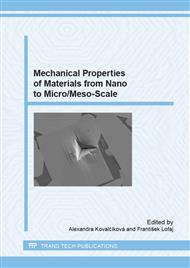[1]
W.C. Oliver, G.M. Pharr, An improved technique for determining hardness and elastic modulus using load and displacement sensing indentation experiments, J. Mater. Res. 7 (1992) 1564–1583.
DOI: 10.1557/jmr.1992.1564
Google Scholar
[2]
B. Jönsson, S. Hogmark, Hardness measurements of thin films, Thin Solid Films 114 (1984) 257-269.
DOI: 10.1016/0040-6090(84)90123-8
Google Scholar
[3]
ISO 14577-7: 2007 Metallic Materials – Instrumented indentation test for hardness and materials parameters, Part 4: Test method for metallic and non-metallic coatings, CEN (2007).
DOI: 10.3403/30091639u
Google Scholar
[4]
P.J. Burnett, D.S. Rickerby, The mechanical properties of wear-resistant coatings. I: Modelling of hardness behaviour, Thin Solid Films 148 (1987) 41-50.
DOI: 10.1016/0040-6090(87)90119-2
Google Scholar
[5]
S.J. Bull, D.S. Rickerby, New developments in the modelling of the hardness and scratch adhesion of thin films, Surf. Coat. Technol. 42 (1990) 149-164.
DOI: 10.1016/0257-8972(90)90121-r
Google Scholar
[6]
A.M. Korsunsky, M.R. McGurk, S.J. Bull, T.F. Page, On the hardness of coated systems, Surf. Coat. Technol. 99 (1998) 171-183.
DOI: 10.1016/s0257-8972(97)00522-7
Google Scholar
[7]
E.S. Puchi-Cabrera, A new model for the computation of the composite hardness of coated systems, Surf. Coat. Technol. 160 (2002) 177-186.
DOI: 10.1016/s0257-8972(02)00394-8
Google Scholar
[8]
A.K. Bhattacharya, W.D. Nix, Finite-element simulation of indentation experiments, Int. J. Solids Struct. 24 (1988) 881-891.
DOI: 10.1016/0020-7683(88)90039-x
Google Scholar
[9]
A. Iost, G. Guillemot, Y. Rudermann, M. Bigerelle, A comparison of models for predicting the true hardness of thin film, Thin Solid Films 524 (2012) 229-237.
DOI: 10.1016/j.tsf.2012.10.017
Google Scholar
[10]
H. Pelletier, J. Crier, A. Cornet, P. Mille, Limits of using bilinear stress-strain curve for finite element modeling of nanoindentation response on bulk materials, Thin Solid Films 379 (2000) 147-155.
DOI: 10.1016/s0040-6090(00)01559-5
Google Scholar
[11]
M. Lichinchi, C. Lenardi, J. Haupt, R. Vitali, Simulation of Berkovich nanoindentation experiment on thin films using the finite element method, Thin Solid Films 312 (1998) 240-248.
DOI: 10.1016/s0040-6090(97)00739-6
Google Scholar
[12]
X. Cai, H. Bangert, Hardness measurements of thin films - determining the critical ratio of depth to thickness using FEM, Thin Solid Films 264 (1995) 59-71.
DOI: 10.1016/0040-6090(95)06569-5
Google Scholar
[13]
Bolshakov, G.M. Pharr, Influence of pile up on the measurement of mechanical properties by load and depth sensing indentation techniques, J. Mater. Res. 13 (1998) 1049-1058.
DOI: 10.1557/jmr.1998.0146
Google Scholar
[14]
A.A. Pelegri, X. Huang, Nanoindentation on soft/hard substrate and hard film/soft substrate material systems with finite element analysis, Comp. Sci. Technol. 68 (2008) 147-155.
DOI: 10.1016/j.compscitech.2007.05.033
Google Scholar
[15]
F. Lofaj, P. Hviščová, L. Kvetková, Hard W-C based coatings by highly ionized sputtering technique, Proc. Vrstvy a povlaky 2014, Kníhviazačstvo, Trenčín (2014) 127-132.
Google Scholar
[16]
P. Hviščová, L. Kvetková, F. Lofaj, M. Novák, M. Ferdinandy, R. Podoba, Mechanical and tribological properties of HiPIMS and HiTUS W-C based coatings, Key Engineering Materials, this issue.
DOI: 10.4028/www.scientific.net/kem.662.99
Google Scholar


